|
Let me state one thing up front: Umberto Lenzi is not a great
director. He is no visionary like fellow Italian genre directors
like Dario Argento, Mario Bava [Mario
Bava bio - click here] or even Sergio Leone, nor is he a genre
auteur like Enzo G.Castellari [Enzo
G.Castellari bio - click here] or Lucio Fulci [Lucio
Fulci bio - click here], not even a
craftsman as gifted as Antonio Margheriti (= Anthony M.Dawson) [Antonio
Margheriti bio - click here] or as wily and enjoyably trashy
as Joe D'Amato [Joe D'Amato bio -
click here]. Umberto Lenzi's directorial style could be best described as Spartan. His films had little room for visual experiments,
and pretty much everything is shot in a straightforward style - which made
him the perfect hired-hand director who could
deliver his films on time and on budget, and who was always willing to
compromise and/or make concessions - and occasionally his films looked it,
some of his films actually look incredibly shoddy. That all said, if given a decent
budget and free reign over his films he could put out quite acceptable
movies - but unfortunately this wasn't always the case ... Having
gotten all that off my chest, it should be pointed out that Lenzi over the
years has become famous (and notorious) primarily for his gore shockers
including several cannibal and zombie films, but actually these films are
only a fraction of his actual output, and at least some of them, despite
being considered cult-items nowadays, are actually among his poorest films
and have gained fame and notoriety solely for their excessive gore scenes. It would be wrong though to label Lenzi simply as a gore
director, he was more of a craftsman who would work equally well (or
un-well) in whichever genre was thrown at him, be it period pieces,
Westerns, gialli, poliziotteschi, cannibal movies, zombie flicks, shockers,
war movies, adventure movies ... and as a consequence, his filmography
closely mirrors the history of Italian genre cinema as such as Lenzi has
made films of whatever genre was popular at any given time ...
Early Life, Early Career
Umberto Lenzi was born in Massa Marittima, Grosseto, Italy on August 6, 1931.
From an early age on, he was fascinated with movies, and he started
various film fan clubs during his days as a student. But despite his love
for cinema, he initially studied law until his true love won the upper
hand and he ditched law school for studying the technical
arts of filmmaking at the Centro Sperimentale de Cinematografia,
where he earned a degree in 1956. After having finished his
studies, Lenzi didn't enter the film industry as such immediately but
wrote articles on films for several publications as well as some fiction
(usually murder mysteries), which he released under various aliases. (Actually,
he continued writing until late in his life, which includes screenplays
for himself as well as for others and the occasional short story, for one
of which, a mystery, he earned an award at the 1983 Cattolica Mystfest.) Eventually
all of his writings opened him the doors to the film industry, and he
intiially became assistant director on a handful of films in the early
1960's, until he was actually offered his first film as a director, a
pirate movie ...
Period Pieces, Peplums,
Pirate Movies - The Early 1960's In the early 1960's,
period pieces formed the bulk of production of Italian genre cinema.
Mainly these were peplums (= Italian sword and sandal movies), but quite a
few pirate movies, Zorro-movies
(with Zorro
not necessarily being restricted to his native America), Robin
Hood movies and the like were being produced as well. And
though the films were all posing as historical dramas/adventures, they
usually did not care much about accuracy or were in the least faithful to
their sources (and you will see what I mean later on). So when
in the early 1960's, an aspiring director wanted to make his first feature
film, he was almost certainly assigned to a period piece of one sort or
another, simply because they were cheap to make (since sets and costumes
were usually shared by many films), an already experienced crew could help
out in case the director failed, these films were almost sure to make
their money back, and many of them could even be exported to the rest of Europe and
sometimes to overseas as well.
In that light it should come
as no surprise that Lenzi's first feature was a pirate movie, Le
Avventure di Mary Read (1961), in which Lisa Gastoni can be seen as
Mary Read, a female corsair, who takes over a pirate ship to wreak havoc
on the high seas. While certainly no classic, the film is
well-enough made to inspire producers to hire Lenzi for more period pieces
of all sorts:
- Duello nella Sila/Duel of Fire (1962) is set in
19th century Europe while Il Trionfo di Robin Hood/The
Triumph of Robin Hood (1962) is yet another reworking of the Robin
Hood legend, starring the relatively unknown American
actor Don Burnett in the lead.
- Caterina di Russia/Catherine of Russia (1963) tells
the story of Catherine the Great (portrayed by Hildegard
Knef) but takes a few too many liberties with history as such to be
taken seriously.
- L'Invincibile Cavaliere Mascherato/Terror
of the Black Mask/The
Invincible Masked Rider (1963) is a Zorro-ish
adventure that also includes horror elements and the bulbonic plague. Pierre Brice plays the lead [Pierre
Brice bio - click here]. For some incomprehensible reason, this film was marketed as a Robin
Hood-picture in German language countries.
- The funniest (if maybe also worst) of this bunch of films though is Zorro
contro Maciste (1963), in which popular characters Zorro
and Maciste
are both torn from their respective historical contexts (19th century
in the former case, antiquity inthe later, though the Maciste-legend
was known to travel in time a little) and pitted against each
other in a fantasy kingdom remotely resembling midieval Spain. In the
finale they unite though to give the baddies their just desserts. Zorro
is in this one played by Pierre Brice, Maciste
by Alan Steel aka Sergio Ciani. Peplum regular Moira Orfei also stars.
Umberto Lenzi next tried his hands on what can be labelled as one of
Italy's (pulp-)literature's greatest heroes, Sandokan,
created by Italian author Emilio Salgari (1862 - 1911). Basically, Sandokan
is a pirate from Malaysia, but his appeal is not so much his murdering and
pillaging but his relentless fight against the British and Dutch
colonialists in the South China Seas.
Umberto Lenzi shot two Sandokan-movies,
both with ex-Mr Universe Steve Reeves (who keeps his shirt on during most
of the movies) in the lead, Sandokan, la Tigre di Mompracem/Sandokan the
Great (1963) and I Pirati della Malesia/Sandokan - Pirate of
Malaysia
(1964) [Steve Reeves bio -
click here]. Both films were quite decently made actually, but looking closely,
you can't help noticing the amount of time Sandokan
the pirate spends on land due to budgetary restraints.
Still, there are waaay worse examples of this in Italian pirate movie
history.
To make the most of the Sandokan-sets
and costumes, Umberto Lenzi made three more similarly-themed movies during
that time,
Sandok, il
Maciste della Giungla/Temple
of the White Elephants (1964) starring Errol's son Sean Flynn, I
Tre Sergenti de Bengala (1964), and La Montagna di Luce/Temple
of a Thousand Lights/Jungle Adventurer, the last two starring Richard Harrison [Richard
Harrison bio - click here], which would also share some of the
cast with the Sandokan-movies.
From today's jaded point of view, sharing sets and costumes
might sound a bit greedy, but actually such tactics would ensure each film higher production values than they could boast on their own ... and
thus all five films actually look pretty good, at least production value
wise.
In between these films Umberto Lenzi also made L'Ultimo
Gladiatore/Messalina
against the Son of Hercules (1964), Lenzi's only actual peplum (despite
the Maciste-character,
Zorro
contro Maciste does not really classify as a peplum due to its
sets and pseudo-historical backgrounds).
This one, set in the times of Caligula
and Messalina,
once again stars Richard Harrison, this time as a gladiator out to
overthrow Rome's evil rulers, with Lisa Gastoni playing Messalina
and Charles Borromel Caligula.
In all, L'Ultimo
Gladiatore fails to stand out of the heaps of peplums made at the
time, with only some torture scenes providing some fun for acquired tastes.
By and large, it simply has to be noted, the sword-and-sandal genre
had run its course by the mid-1960's ...
Thrillers, Espionage,
Westerns, War - The Late 1960's
Umberto Lenzi was nothing if not versatile (which you had to
be as an Italian genre director in the 1960's to remain in business), in
the mid-1960's he easily shook the confines of period pieces and adapted
to whatever was thrown at him - which immediately were a handful of
espionage inspired by the then immensely popular James Bond
movies: A 008: Operazione Sterminio (1965), Superseven
chiama Cairo/Super
Seven Calling Cairo (1965), Le Spie Amano i Fiori (1966) and Un
Milione di Dollari per Sette Assassini/Last Man to Kill (1966)
all didn't even try to set themselves apart from the James Bond-series (words like A 008 and Superseven in the title were
obviously not chosen by chance), but quite in general, Italian espionage
movies never had the budget, the scripts or indeed the cast to challenge
the British superspy-series, and by and large, these films seem ridiculous
from today's point of view (Lenzi's films included), though at times
ridiculous in an entertaining way.
| 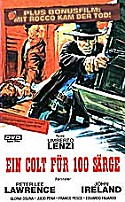
 Flix.com Flix.com
|
|
The big
moviegenre in mid-1960's Italy though was the Western, and Lenzi of course
made a couple of them as well, Tutto per Tutto and Una
Pistole per Cento Bare (both 1968), which were ok but quite
unremarkable genre entries. Same can probably be said about his war films,
Attentato ai tre Grandi/Desert Commandos (1967) and La
Legione dei Dannati/Legion of the Damned (1969), which first
and foremost shared the fate of most of Italian war films from the late
1960's - a serious lack of budget, which results of course in a lack of
spectacular setpieces ... still, interestingly enough, Lenzi would return
to the war genre quite frequently, and only rarely with adequate budgets
... Lenzi's first real claim for fame though arrived in 1966,
with his film Kriminal.
Kriminal was the story of a
supercriminal who commits all his crimes in a black bodysuit with a
skeleton painted on it, based on the popular Italian comicstrip by writer
Max Bunker (Luciano Secchi) and artist Magnus (Roberto Raviola). The Kriminal-comicstrips
actually were fumetti neri, which literally means black
comics and refers to their anithero- or even villainous lead characters.
The film Kriminal, with Glenn Saxson in the lead, works pretty much
along the lines of then-popular espionage films (of which Umberto Lenzi
made quite a few, see above) but is more stylish and playful than your
typical James Bond-rip off, and not at least thanks to its
stylishness and intentionally campy elements it has since become a bit of
a cult item (even though it was always overshadowed by Mario Bava's
similarly themed Diabolik/Danger:
Diabolik from 1968, and deservedly so). However, Kriminal
was actually more important in being the first fumetti neri being brought
to the big screen, and over the next few years, quite a few would follow
... Eventually, the film Kriminal proved successful enough to
spawn a sequel, Il Marchio di Kriminal, in 1968, which was not
directed by Lenzi though but by Fernando Cerchio. It was
however another genre that Umberto Lenzi made his own in the late 1960's: The giallo. The giallo - a distinctive Italian version of
the traditional murder mystery often involving psychopaths and horror
elements - was back then still in its infancy (Dario Argento, who is
nowadays considered as the visionary of the genre, made his first giallo L'Ucello
dalle Piume di Cristallo/The
Bird with the Crystal Plumage only in 1969) and was initially
little more than an attempt to cash in on the then immensely popular German
Edgar Wallace series - but just like the spaghetti Western
which was spawned by the German Winnetou
series, the giallo developed into something generic before long. Umberto
Lenzi had a special affinity to the giallo genre because he had written
several murder mystery stories over the years and it was
a genre he really loved, too. Lenzi's first giallo, Orgasmo/Paranoid
(1969) did actually come out almost a full year before Argento's first,
even if it ultimately did not have the same impact as Argento's film(s),
and of course it was not the first ever giallo. Still, the film
had everything that would soon become a genre mainstay: an overly
complicated plot full of murder and blackmail, its fair share of sex, and
plottwists aplenty that are simply too outrageous to come across as believable.
But stil, casting plausibility away for a moment, in itself, Orgasmo,
the story of a widowed and wealthy American woman (Carroll Baker) who
falls prey to a couple of golddiggers (Lou Castel, Colette Descombes),
actually works if taken as a genre flick, and it became a big success in
Italy as well as quite successful internationally - successful enough for
Lenzi to also cast Carroll Baker again for his next two gialli, Cosi Dolce ... così
Perversa/So Sweet ... so Perverse (1969) and Paranoia/A
Quiet Place to Kill (1970) - this one obviously titled to cash in on
the international title of Orgasmo - as well as his later Il Coltello
di Ghiaccio/Silent Horror/Knife of Ice (1972), which,
believe it or not, is also a giallo ...
Gialli and Poliziotteschi -
The 1970's a.k.a. The Golden Years Arguably, the 1970's -
and I mean especially the first half - were the golden age fof Italian genre
cinema: Much of the output of the Italian film industry was distributed
internationally, be it murder mysteries (or gialli), cop movies (or
poliziotteschi), sex movies or horror flicks - and quite naturally,
international marketability meant higher budgets and thus higher
production values. Plus, by and large, Italian genre films from that era
had a certain look to them that was simply lacking in films from
earlier eras.
The heyday of Italian genre cinema of course also
meant that Lenzi's career during that era was doing extremely well, and
his films looked the best and slickest in the former half of the 1970's. He
started the decade by doing more gialli, above mentioned A Quiet Place
to Kill as well as Un Posto Ideale per Uccidere/Deadly Trap/Oasis
of Fear/Dirty Pictures (1971), Sette
Orchidee Macchiate di Rosso/Seven
Blood-Stained Orchids/Das
Rätsel des Silbernen Halbmonds (1972) - this being one of the
last films of German production company Rialto's
Edgar
Wallace series -, above mentioned Silent Horror, Spasmo/The
Death Dealer (1974) and Gatti Rossi in un Labirinto di Vetro/The
Eye/Secret Killer/Eyeball (1975), which were maybe no
masterpieces, but uniformly well-made and stylistically accomplished murder mysteries. Sure, most of
them had plots that defied plausibility, but in all honesty, this is
something they shared with the giallo genre as a whole.
The other genre that has become very popular was the cop movie or poliziottesco.
Basically, polizioteschi were violent, police-themed action movies
(as opposed to, let's say, police procedurals), full of car chases,
explosions and shoot-outs with heroes who often saw themselves above the
law to get their results, and they were definitely from the more
exploitative end of the cop movie genre as such. And while there were
Italian cop
movies before the 1970's and even the occasional film that could have been
labeled poliziottesco, the genre came into full swing following the
successes of US-American cop flicks like Dirty Harry (1971, Don
Siegel), French Connection (1971, William Friedkin) and Serpico
(1973, Sidney Lumet). Death Wish (1974, Michael Winner), though
technically not a cop movie, also had an impact on the poliziottesco. What
set poliziotteschi apart from their American inspirations though was
that they did often include Italian political and socio-economic
situations in their
plots, and not only for that they were unmistakably Italian. Key
directors of the genre were Fernando di Leo, Enzo G.Castellari [Enzo
G.Castellari bio - click here] and Umberto Lenzi - with,
truth to be told, Lenzi being possibly the least talented and interesting of the three,
but still he turned out many an exciting poliziottesco during the 1970's,
as his Spartan directorial style actually fitted the genre quite well, and he proved to indeed be able to handle complex action sequences
with ease.
| 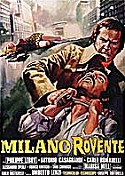
 Flix.com Flix.com
|
|
Lenzi became involved in the genre via a gangster
flick, Milano Rovente/Burning City/Gangwar in Milan
(1973), which dealt with Italian pimp Antonio Sabato putting up a fight
against French drug
kingpin Philippe Leroy because he couldn't accept the low standards of the
Frenchman who was already trying to take over his territory. By
definition, Milano Rovente was of course not a poliziottesco (no
cops as lead characters), but in concept - a violent tough guy loner with
a set of rules of his own fighting an evil syndicate that easily outguns him - the film was very much
in tune with the neighbouring genre.
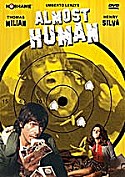
 Flix.com Flix.com
|
| |
Milano Odia: La Polizia
non puo Sparare/Almost Human/The Kidnap of Mary Lou (1974) is Lenzi's
first poliziottesco per se. In this one, the slightly insane small time
crook Tomas Milian tries to hit the jackpot by kidnapping Laura Belli, the
daughter of a rich man. Cop Henry Silva sees to it that things are put
right again, no matter what the cost.
Lenzi kept Tomas Milian from Almost Human for Roma a Mano Armata/Rome Armed to
the Teeth (1976), but this
time around he plays a machine gun carrying psycho-hunchback pitted
against cop Maurizio Merli. Maurizio Merli was effective enough that he returned
as a cop later that year in Napoli Violenta/Violent Naples
(1976), while in Il Trucido e lo Sbirro/Tough Cop/Free
Hand for a Tough Cop (1976), Milian is back, this time playing a drug
dealer who the titular tough cop Claudio Cassinelli teams up with to save
a kidnap victim from gangster kingpin Henry Silva. Interestingly, Milian's
character was so popular in this film that two more films were made about
him, La Banda del Trucido/Destruction Force (1977) by
Stelvio Massi and La Banda del Gobbo/Brothers till we Die
(1978), again by Lenzi himself, the latter actually having been co-scripted by
Milian. These three films though all had an ironic edge to it missing from
Lenzi's earlier work.
Il
Cinico, l'Infame, il Violento/The
Cynic, the Rat and the Fist (1977) is a direct sequel to Rome Armed to
the Teeth, and again it pits Maurizio Merli against Tomas Milian (and
John Saxon [John Saxon bio -
click here] for that matter, who was also in Violent Naples), but
that's not to say the film is purely derivative. Actually, The
Cynic, the Rat and the Fist is a pretty effective and fast-paced
crime thriller in its own right. Da Corleone a Brooklyn/From
Corleone to Brooklyn/The Sicilian Boss (1979) quite obviously
tries to liken itself to Francis Ford Coppola's Godfather-series
titlewise, but actually it's another effective poliziottesco starring
Maurizio Merli.
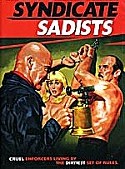
 Flix.com Flix.com
|
| |
|
|
|
|
Apart from gialli and poliziotteschi, Lenzi only
made a handful of other films, crime thrillers (L'Uomo della Strada fa
Giustizia/Manhunt in the City and Il Giustiziere sfida la
Città/Syndicate Sadists/Rambo's Revenge [both 1975]),
war films (Il Grande Attacco/Battle Force/The Great Battle
[1978] with a stellar cast including Henry Fonda, Orson Welles, Stacy Keach, Helmut Berger,
Samantha Eggar, Giuliano Gemma, John Huston and Edwige Fenech and Contro
4 Bandiere/From Hell to Victory [1979] starring George Peppard,
George Hamilton, Horst Buchholz and Capucine) and a sex comedy (Scusi,
lei e Normale ? [1979]). However, the film from the 1970's that has
brought Umberto Lenzi the most recognition internationally and has really
put his name on the map of exploitation film was of another genre
altogether: violent adventure, or the cannibal movie to be more precise
...
Jungle Adventures:
Umberto Lenzi and the Cannibals
| 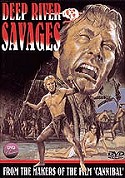
 Flix.com Flix.com
|
|
| 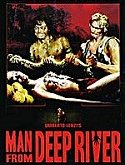
 Flix.com Flix.com
|
|
In 1972, Umberto Lenzi was still making gialli, almost exclusively
actually, but for Il
Paese del Sesso Selvaggio/Deep
River Savages, he
left the genre (and Italy as such) behind for a bit to film this jungle
adventure movie in Thailand. The film is a very savage adventure movie
that tells the story of a white man (Ivan Rassimov) getting lost in the
jungles of Thailand and getting picked up by a tribe of natives who just
won't let him go anymore ... and slowly the white man comes to terms with
living among the natives. Of course, the fact that he and he daughter (Me
Me Lai [Me Me Lai bio - click here])
of the chief have fallen in love makes things a lot easier for him, but
even after she dies giving birth to his child, he feels he does indeed
belong to the tribe now. In itself, the film, a competent adventure
movie that fitted Lenzi's rather Spartan directorial style perfectly,
would probably not have caused much of a sensation wouldn't it have contained
some very graphic cannibal scenes that in their explicitness were unheard
of at the time. And even though the cannibals are mere supporting
characters in Deep
River Savages and their scenes only make up a small portion
of the film, the movie is (with some justification) laneled the first
Italian cannibal movie and has therefore become a part of exploitation
cinema history. Still, the film did not kickstart the cannibal
genre by itself and did not find many imitators immediately after its
release - which is significant in itself since the Italian filmindustry
was traditionally quick in imitating any box office success. It
wasn't until 5 years later actually that another Italian cannibal movie
would be made, Ultimo Mondo Cannibale/Jungle
Holocaust (1977), a film directed by Ruggero Deodato [Ruggero Deodato bio - click here], which was a more all-out
cannibal flick than Deep
River Savages. Later, both Lenzi and Deodato would claim to have
invented the genre as such, a question that can be answered in two ways:
While Deodato put the cannibals center stage in his movie, he was quite
obviously influenced by Lenzi's film - up to a point where he re-cast Deep
River Savages' two leads Ivan Rassimov and Me Me Lai. (Whoever
invented the cannibal genre as such though, it's no doubt that it was
indeed Ruggero Deodato who made the ultimate cannibal movie, Cannibal
Holocaust [1980].)

 Flix.com Flix.com
|
| |
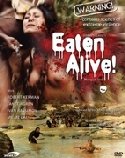
 Flix.com Flix.com
|
| |
Jungle
Holocaust became quite a success and spawned a host of imitators,
and thus it was only a question of time until Umberto Lenzi would be called
back to the genre: In 1980 he made Mangiati
Vivi/Eaten Alive,
a film that combines cannibal genre mainstays with various facts about the
Jonestown Massacre to a rather odd melange, and once again Lenzi used
Me Me Lai and Ivan Rassimov in lead roles. But while Deep
River Savages was a serious if exploitative adventure film, Eaten Alive
was pure trash, coming up with excuse after excuse to show extreme
violence (also against animals, a genre trademark), nude women or
even both. Plus, to cut costs, many scenes (and I especially mean costly
gore scenes) were re-used from earlier movies like Deep
River Savages, Jungle
Holocaust and La Montagna
del Dio Cannibale/The Mountain of the Cannibal God (1978,
Sergio Martino), for example Me Me Lai's extended death scene was
completely lifted from Jungle
Holocaust. Taken seriously, Eaten Alive
is of course less than satisfying, but it has this certain so-bad-it's-good
quality to it that (to trash fans like me) makes it extremely entertaining
in its own way.
| 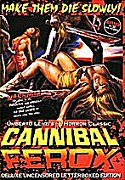
 Flix.com Flix.com
|
|
| 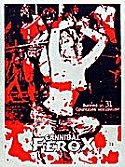
 Flix.com Flix.com
|
|
| 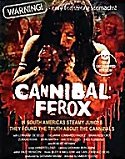
 Flix.com Flix.com
|
|
The same can unfortunately not be said about Cannibal
Ferox/Make Them
Die Slowly (1981), Lenzi's final cannibal film. This film is about
a group of stupid youngsters out inthe jungle to prove that there is no such thing as
cannibalism - only to be proven wrong, and savagely so. In this film, the
plot is little more than an excuse to show scene after scene of extreme violence (as
you might have guessed from my synopsis) with no suspense, no likeable
characters, and not even all that talented actors. In a way it's Lenzi at
his worst, and also a precursor of things to come in the 1980's. Umberto
Lenzi returned to the jungle once again in 1982, but this time not to find
cannibals but to find your typical jungle girl in the form of Sabrina
Siani in Incontro nell'Ultimo Paradiso/Daughter of the Jungle/Adventures
in Last Paradise, and rather than a gore film this one is an erotic
comedy. (Speaking of jungle films, it scould possibly also be mentioned that Lenzi also
was involved in writing the Tarzan
film Tarzán en la Gruta del Oro/Zan,
King of the Jungle [Manuel
Cano] in 1969, one in a series of unauthorized Spanish Tarzan
movies.)
The Decline - The
1980's After the 1970's, which were a golden age
for Italian genre cinema, the decline came all too rapidly in the 1980's.
Basically, Italian films were driven out of the cinemas by US American
blockbusters, a phenomenon that didn't even surface as such until the mid-
to late 1970's and that now began to demand its toll. As a consequence, it
seems that the Italians have lost all trust into their own creativity in
the 1980's, and instead of making some generic films, they concentrated on
making rip-offs of every (genre-)movie that was doing well at the box
office, even if Italian films could not compete with their American
counterparts on a budgetary level and often also lacked the technical
prerequisites - which caused films from that era to look often shoddy and
almost always derivative, but also often funny in their own (sometimes
unintentional) way. (Truth to be told, the Italians also were not shy to
copy successful film concepts in previous decades as well, but never were
they so unashamed at it as in the 1980's.)
Being the perfect genre director as it is,
Umberto Lenzi was of course no exception to this trend:
| 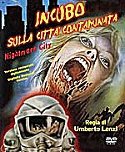
 Flix.com Flix.com
|
|
- Quite obviously,
the zombie film Incubo sulla Città Contaminata/Nightmare City
(1980) - filmed between his two cannibal flicks - was inspired by George
A.Romero's Dawn of the
Dead (1978), and though it was not on par with that movie on any
level (least of all the underlying parody of Romero's film), it is
nevertheless one of the better Italian zombie movies from that period.
- La
Guerra del Ferro - Ironmaster/Ironmaster (1983) a barbarian
flick set in the iron age to cash in on the success of Conan
the Barbarian (1982) on the other hand is pretty much
bottom-of-the-barrel entertainment - though admittedly, Italian barbarian
movies from that era did look shoddy almost by definition.
- Nightmare
Beach/Welcome to Spring Break (1988), an American production, is pretty much your standard
cheap and uninteresting slasher, with Lenzi's Spartan directorial
style translating into uninspired. Actually there is very little
this film has to go for it, and why the American producers needed to hire
an Italian director to deliver a film as routine as this is beyond me.
| 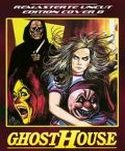
 Flix.com Flix.com
|
|
- La Casa 3/Ghosthouse
(1988) and Paura nel Buio/Hitcher in the Dark/Hitcher 2
(1989), both produced by Joe D'Amato's Filmirage [Joe D'Amato bio -
click here], were rip-offs of the Evil
Dead-series (titled La Casa in Italy) and The Hitcher (1986, Robert Harmon)
respectively even in title, however, they never even remotely reached
their inspirations' effectiveness ... in fact both films are atrocious and
among the worst Lenzi ever directed.
Apart from these rip-offs, Lenzi directed a few more horror films in
the 1980's (Le Porte dell'Inferno/Hell's
Gate/Gate of Hell, and La
Casa del Sortilegio/House
of Witchcraft and La
Casa delle Anime Erranti/House
of Lost Souls [all 1989] - the last two being parts of an unaired
TV-series, Le
Case del Terrore, for which Lucio Fulci [Lucio
Fulci bio - click here] also made two films), but nothing really
worthwhile. Also in the 1980's, he tried his hands on comedy (Pierino
la Peste alla Riscossa and Cicciabomba [both 1982]), with only
moderate success.
Of more interest might be the handful of
Italo-Yugoslavian World War II movies (I Cinque del Condor/Thunder
Squad/Wild Team [1985], Un Ponte per l'Inferno/A
Bridge to Hell [1986] and Tempi di Guerra/Wartime
[1987]) Lenzi made in the mid-1980's, if not necessarily for their
inherent qualities but their almost obvious cheapness: All the more
elaborte action scenes in these films are lifted from somewhere else and
clumsily edited in, the actors are for the most part no-names (with almost all
supporting roles cast with presumably cheaper Yugoslavian actors), and the plots
are little more than tired routine. In fact it has to be credited to Umberto
Lenzi that the films did not turn out to be total desasters.
Fade-out: The 1990's
In the 1990's, Italian genre cinema, which had experienced a surge
thanks to the home video boom of the mid-1980's, was finally down on its
knees, and consequently, Umberto Lenzi only made a few more films.
- The crime action flicks Detective Malone/Black Cobra 4/Code-Name
Insallah (1990, starring Fred Williamson), Cop Target
(1990, starring Robert Ginty and Charles Napier) and Hornsby e Rodriguez - sfida
Criminale (1992, starring Charles Napier) simply paled compared to
his poliziotteschi from the 1970's.
| 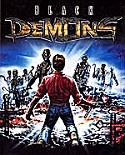
 Flix.com Flix.com
|
|
- Demoni 3/Black Demons/Black Zombies (1991), a
cheaply produced zombie-shocker, is quite simply put atrocious.
- Even worse though is Caccia allo Scorpione d'Oro/Hunt for
the Golden Scorpion (1991), an adventure movie about a treasure
hunt in some jungle or other which is to a good part made up from
action scenes from a warmovie - which don't at all match the newly
shot scenes, making the whole film a very schizophrenic experience.
Umberto Lenzi's last film (so far ?) is 1996's Sarayevo Inferno di
Fuoco, a warmovie that left surprisingly little impact on anyone and
that seems to to this day never have come out anywhere.
Lenzi, then aged 65, retired after this movie, and probably it was for the
best: Italy did no longer offer a director of his ilk the prerequisites to
make good films, instead from the early 1980's onwards he was pretty much
forced to churn out one underbudgeted genre piece after another, films
that effectively ruined the reputation he had built up for himself in the
1970's with solid genre entertainment.
And while Lenzi was no great director in any sense of the word,
he was a talented craftsman who could turn out quite entertaining fare, and
he should not be remembered by garbage like Hunt
for the Golden Scorpion, Black Demons or Ghosthouse,
not even by the trashy but funny Eaten Alive,
but by films like Orgasmo, Deep
River Savages, Milano Rovente or Rome Armed to the Teeth,
which might not be perfect films but good genre entertainment - and that's
all someone like me needs every now and again ...
|